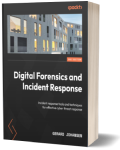Digital Forensics and Incident Response
Cybersecurity
Book Details
Book Title
Digital Forensics and Incident Response Incident response tools and techniques for effective cyber threat response Edition: 3
Author
Gerard Johansen
Publisher
Packt Publishing
Publication Date
2022
ISBN
9781803238678
Number of Pages
532
Language
English
Format
File Size
11.4MB
Subject
Computers > Security
Table of Contents
- Cover
- Title Page
- Copyright
- Contributors
- Table of Contents
- Preface
- Part 1: Foundations of Incident Response and Digital Forensics
- Chapter 1: Understanding Incident Response
- The IR process
- The IR framework
- The IR plan
- The IR playbook/handbook
- Testing the IR framework
- Summary
- Questions
- Further reading
- Chapter 2: Managing Cyber Incidents
- Engaging the incident response team
- SOAR
- Incorporating crisis communications
- Incorporating containment strategies
- Getting back to normal – eradication, recovery, and post-incident activity
- Summary
- Questions
- Further reading
- Chapter 3: Fundamentals of Digital Forensics
- An overview of forensic science
- Locard’s exchange principle
- Legal issues in digital forensics
- Forensic procedures in incident response
- Summary
- Questions
- Further reading
- Chapter 4: Investigation Methodology
- An intrusion analysis case study: The Cuckoo’s Egg
- Types of incident investigation analysis
- Functional digital forensic investigation methodology
- The cyber kill chain
- The diamond model of intrusion analysis
- Summary
- Questions
- Part 2: Evidence Acquisition
- Chapter 5: Collecting Network Evidence
- An overview of network evidence
- Firewalls and proxy logs
- NetFlow
- Packet capture
- Wireshark
- Evidence collection
- Summary
- Questions
- Further reading
- Chapter 6: Acquiring Host-Based Evidence
- Preparation
- Order of volatility
- Evidence acquisition
- Acquiring volatile memory
- Acquiring non-volatile evidence
- Summary
- Questions
- Further reading
- Chapter 7: Remote Evidence Collection
- Enterprise incident response challenges
- Endpoint detection and response
- Velociraptor overview and deployment
- Velociraptor scenarios
- Summary
- Questions
- Chapter 8: Forensic Imaging
- Understanding forensic imaging
- Tools for imaging
- Preparing a staging drive
- Using write blockers
- Imaging techniques
- Summary
- Questions
- Further reading
- Part 3: Evidence Analysis
- Chapter 9: Analyzing Network Evidence
- Network evidence overview
- Analyzing firewall and proxy logs
- Analyzing NetFlow
- Analyzing packet captures
- Summary
- Questions
- Further reading
- Chapter 10: Analyzing System Memory
- Memory analysis overview
- Memory analysis methodology
- Memory analysis tools
- Memory analysis with Strings
- Summary
- Questions
- Further reading
- Chapter 11: Analyzing System Storage
- Forensic platforms
- Autopsy
- Master File Table analysis
- Prefetch analysis
- Registry analysis
- Summary
- Questions
- Further reading
- Chapter 12: Analyzing Log Files
- Logs and log management
- Working with SIEMs
- Windows Logs
- Analyzing Windows Event Logs
- Summary
- Questions
- Further reading
- Chapter 13: Writing the Incident Report
- Documentation overview
- Executive summary
- Incident investigation report
- Forensic report
- Preparing the incident and forensic report
- Summary
- Questions
- Further reading
- Part 4: Ransomware Incident Response
- Chapter 14: Ransomware Preparation and Response
- History of ransomware
- Conti ransomware case study
- Proper ransomware preparation
- Eradication and recovery
- Summary
- Questions
- Further reading
- Chapter 15: Ransomware Investigations
- Ransomware initial access and execution
- Discovering credential access and theft
- Investigating post-exploitation frameworks
- Command and Control
- Investigating lateral movement techniques
- Summary
- Questions
- Further reading
- Part 5: Threat Intelligence and Hunting
- Chapter 16: Malware Analysis for Incident Response
- Malware analysis overview
- Setting up a malware sandbox
- Static analysis
- Dynamic analysis
- ClamAV
- YARA
- Summary
- Questions
- Further reading
- Chapter 17: Leveraging Threat Intelligence
- Threat intelligence overview
- Sourcing threat intelligence
- The MITRE ATT&CK framework
- Working with IOCs and IOAs
- Threat intelligence and incident response
- Summary
- Questions
- Further reading
- Chapter 18: Threat Hunting
- Threat hunting overview
- Crafting a hypothesis
- Planning a hunt
- Digital forensic techniques for threat hunting
- EDR for threat hunting
- Summary
- Questions
- Further reading
- Appendix
- Assessments
- Index
- About Packt
- Other Books You May Enjoy
